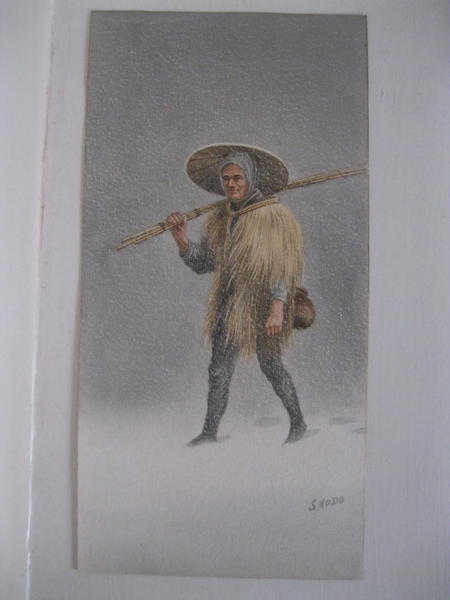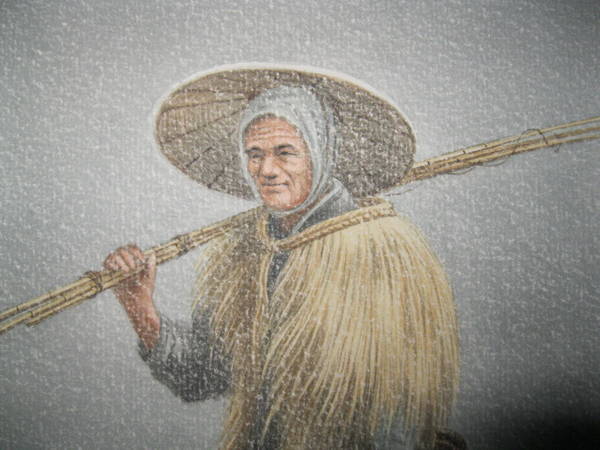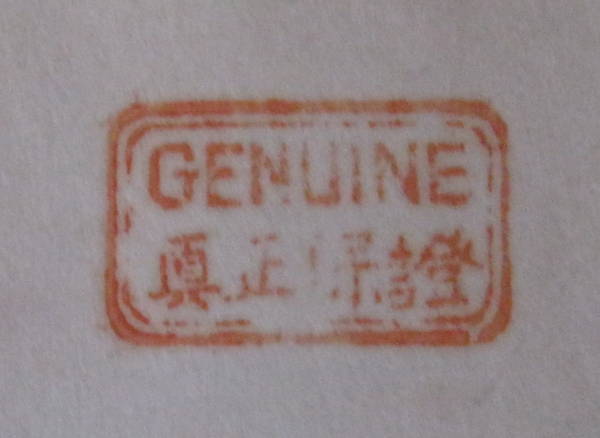| | |
| Artist: | Saito Hodo (a.c. early 1930s) — ほ堂 |
| Title: | Fisherman in snow |
| Series: | |
| Date of first edition?: | 1930 (in the decade of) |
| Publisher (first edition)?: | Self |
| Publisher (this edition)?: | Self |
| Medium (first edition): | Watercolour |
| Medium (this edition): | Watercolour |
| Format (first edition): | Mitsugiri
|
| Format (this edition): | Mitsugiri |
| DB artwork code: | 44453 |
| Notes (first edition)?: |
Dear Dr Walker,
I am actually a collector of oriental ceramics, including Japanese. Occasionally though, I will buy an item of oriental artwork if it “sings” to me. Yesterday I bought an original Japanese watercolour, framed and behind glass, at auction in Lytham At Annes, UK. (Gerrards Auction Rooms). The picture, described as a fisherman in snow, is approx 14” by 7.5” and is signed S. Hodo. While researching the artist today, I have chanced upon one of your websites and I notice a remarkably, similarly executed watercolour in your collection entitled “Pilgrim in Snow”. Do you know if our pictures are two of a series comprising a range of different characters?
I have attached a couple of photos by way of provenance and interest. The red stamp reading “Genuine”, is on the folded backing paper behind the picture, not the actual thick art paper to which the watercolours have been applied. There is also what appears to a distributor’s label on the back of the frame’s wooden backing piece which reads. “H TAKEMURA & CO, 15 Bentendori, Yokohama, Japan”.
Hello xxxx,
Thanks for the images; I'll add them to my JAODB research database if you don't mind.
I think Saito Hodo painted these scenes for the foreign tourist market in the 1930s, so it is possible to see many similar scenes among his works.
Season's greetings,
Ross |
|
| Notes (this edition)?: |
|
| Artist Bio: |
Saito Hodo was a woodblock print and watercolour artist. His woodblock prints were published via Takemura Hideo in Yokohama in the early 1930s, and we therefore assume his watercolours also date to this period. His prints were simply signed with his 'gago' (artist pseudonym) 'Hodo', and sealed 'Ho', with no indication of the family name (as is usual practice). His watercolours are signed 'H. Saito', being his family name (Saito) plus the first initial of his gago 'H'. Initially there was no conclusive evidence that the woodblock print artist Hodo was the watercolour artist H. Saito, although the styles were very similar, and they both worked with the publisher Takemura. The 'missing link' finally came to me in the form of this watercolour and this woodblock print, where we can see they are signed as H. Saito and Hodo, respectively.
Interestingly, there was also another watercolour and woodblock print artist that published via Takemura: Nishimura Hodo. The style and subject matter of Nishimura prints is strikingly similar to that of Saito, to the point where one can reasonably assume they are one in the same artist. Now while it is not unusual for an artist to use different 'gagos' during their artistic career, it is highly unusual for an artist to change their family name, so there is still a possibility that Saito and Nishimura were two different artists. An alternative explanation is that perhaps Saito took on the family name of his wife when he married (assuming her family name was Nishimura; pure speculation of course, but not impossible). While not a common custom here in Japan, this still occasionally occurs today in the case where the wife's family has no male heir. Dated examples of Saito Hodo prints confirm the artist was active in 1933, and there are no prints with a later dating. Furthermore, the earliest dated example of a Nishimura print dates to around 1935, with dated publications continuing up until 1941. So Saito's adoption of the Nishimura name around 1934/35 would fit this scenario.
Yet another explanation is that the attribution of the "Nishimura" family name to the artist Hodo may simply be a mis-attribution, and we have all simply regurgitated this mistaken attribution to the point were it has become commonly accepted as fact. I can't remember ever seeing an artwork or publisher note that mentions the name "Nishimura" when referring to any of the Hodo prints, so I would be interested in hearing from any scholar or collector that can provide such a link.
|
|




